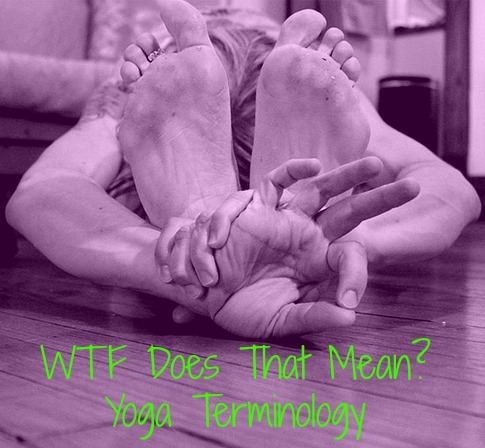WTF Does That Mean? Yoga Terminology
So, you’ve got the mat, the trendy yoga wear and a new pedicure, but are you ready to perform your first ardha matsyendrasana*?
HUH? Do WHAT???
No worries, you don’t need to be a linguistic specialist to attend yoga. Thankfully all of the ancient Sanskrit terms have English translations, but it doesn’t hurt to have a general knowledge of anatomy and to understand a few basics before diving in.
This edition of the WTF Does That Mean Series might not help you tackle a spinal twist*, but hopefully it will help you feel less apprehensive when you first hit the mat.
Common Yoga Terms
Asanas: The poses or postures( like downward facing dog, cobra, corpse pose, etc …).
Prana: The life force that flows through your body.
Pranayama: The breath that controls the prana, creates and directs energy, builds heat.
Ujjayi (pronounced oo-jai): A breathing technique used to calm your mind and bring body awareness. With your mouth closed, draw air through the nostrils, fully expanding the lungs. Exhale through the nose (mouth closed) while contracting the back of the throat. This will produce a rhythmic ocean sound. Confused? Repeat the same action except exhale with your mouth open first (like fogging a mirror). Then repeat with your lips closed.
Drishti: Gaze, focus or focal point. Aids concentration; also refers to looking inward.
Mantra: A single syllable, word or verse used to quiet the mind and create focus. Example: the universal Om.
Sun Salutation: Or in Sanskrit surya namaskar, is a sequence of poses used to limber up the body and prepare for the work or the asanas that follow.
Namaste: Literal translation is “I bow to the divine in you.” Place the hands together at the heart, close the eyes and bow the head. It is unnecessary to verbalize the word, as the gesture alone signifies the meaning.
Third eye: Located in the middle of your forehead, the third eye is fairly mystical and refers to higher consciousness.
Sacrum: A large triangular bone located at the base of the spine. It’s the same spot where you place your hands (fingers pointing down) to arch your back when you’ve been sitting too long.
Sits or Sitz Bones: The two bony protrusions located at the lowest part of the pelvis that takes our weight when we sit. Most of us have ample flesh covering these two points and don’t often really feel them. To get acquainted with your sitz bones, sit on the floor with your legs extended, grab the right cheek and move the flesh out to the side. Repeat on the left. Found ’em!
Perineum: There is really no way to sugarcoat this one folks; it’s the area between the anus and the vagina (or scrotum for guys). To engage the perineum, or the mula bandha, tighten the muscles of the associated area, just like you do when you stop the stream of pee. Some instructors refer to this as the pelvic floor. Engaging the perineum helps to increase core strength and stability while creating energy.
Yoga is a great way to increase flexibility, build strength, manage stress and create a general sense of well-being. There are many types of yoga and most practitioners or yogis (that’s you!) experiment with a few before finding their nitch.
Do you know your sirsasana from your virasana? I’ve been doing yoga for years and still only know a handful of terms. Thank goodness for English! —Karen


Comments
Crazy terms 😛
I recognize most of the Sanskrit names for the most commonly used asanas but I can’t usually think of them myself. Offhand I can throw out the words “Bakasana” (crow) or “Natarajasana” (Dancer’s pose) but couldn’t tell you what wheel pose is called. However if you SAID the name for wheel pose I would remember it. Funny how that works.
Comments are closed.